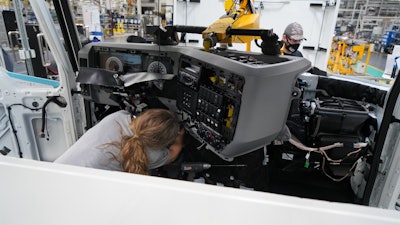
As new truck and trailer orders have stagnated for most of 2021, a lot of blame has been placed at the foot of the industry’s fractured supply chain. Equipment demand remains at or near record highs, but with semiconductors and dozens of other raw materials becoming increasingly hard to acquire and ship, truck and trailer manufacturers have been put in the unenviable position of trying to solve a demand crisis with one hand (or production line) tied behind their back.
No manufacturer has solved the problem, though nearly a year into the crisis many of trucking’s OEMs have implemented alternative sourcing and assembly strategies to maximize their production output and move as much new equipment into the market as possible.
Yet with the fundamental issues impacting productivity unlikely to alleviate any time soon, few OEMs seem willing to express confidence for the year ahead. Industry order boards are filled and few, if any, extra slots appear likely to appear in the months ahead.
At Navistar the order board for 2022 has been closed for “some time now,” says Paul Martin, vice president, Used Truck, Pricing and Sales Finance. Martin says most International trucks scheduled to be produced next year were ordered in the spring, before the worst of the supply constraints limiting the company’s production appeared.
Martin says Navistar has “allocated slots to dealers and customers and are focused on maximizing what we can produce. We want to continue to make sure to treat all parties fairly. Unfortunately, no one is getting nearly as many slots as they might like.”
[RELATED: HDMA Pulse webinar spotlights ports in parts shortage]
The story is similar at Isuzu Commercial Truck of America, which has been forced to shift some 2021 orders into next year as production delays have mounted. Isuzu relies on a dealer-by-dealer allocation system to determine its build plan.
“We use the allocation system to establish the trucks that can be built under the information we have at the time,” the company says.
Conveying this bad news to dealers and fleets is undoubtedly a challenge.
Volvo Truck North America’s Magnus Koeck, vice president, strategy, marketing and brand management, says constant communication with all impacted parties has proven to be the best way to lessen the blow. Koeck says demand continues to be strong — far outpacing supply — indicating customers still want to order as much as possible.
“We share concrete and pertinent information with the Volvo Trucks dealer network when it becomes available so that they can, in turn, update their customers regarding vehicle delivery status updates,” he says. “Our fleet customers receive this same information through their dedicated Volvo sales representatives.”
 Class 8 truck orders have fluctuated between 23,000 and 28,000 units for five of the last six months as OEMs struggle to ramp up production.
Class 8 truck orders have fluctuated between 23,000 and 28,000 units for five of the last six months as OEMs struggle to ramp up production.
Jonathan Randall, Mack senior vice president of sales and commercial operations, agrees. He says Mack experienced a 115 percent increase in orders from the second to third quarter in 2021, and demand remains high.
“Understanding the effect late deliveries have on our customers, Mack is focused on doing everything possible to meet our committed delivery dates, and we will continue to communicate frequently with our dealers and customers as circumstances change to allow for them to better plan ahead,” he says.
The story is the same in the trailer space.
“We’re performing the best we can considering the current circumstances,” states Utility Trailer Manufacturing Company. “Supply chain challenges abound and show no sign of abating. Demand remains strong so far, in the face of unprecedented price increases.”
Wabash National has been able to “fulfill most of our orders” for 2021, but has pushed some units into 2022, says Tim Griesgraber, vice president, strategic accounts.
[RELATED: Communications vital to serving customers during parts shortage]
“As we continue to become accustomed to the current dynamic environment we are in, we have created a very diligent demand and order process to create better predictability for our customers,” Griesgraber says. “We anticipate continued supply challenges so our process will account for those dynamics inclusive of customer communication and being dynamic with our supplier partners when there are supply shortages.”
He says most customers have accepted the delays as well as they can. “Many of our customers have been very understanding because they are dealing with their own supply constraints. Our customers understand the situation and simply want to know what they can plan for.”
But OEMs note predicting the months ahead is unreasonable. No one wants to reduce order boards further, but market uncertainty makes it tough for any OEM to guarantee production levels in the coming year.
“Great Dane’s backlog is mostly committed for 2022, but with so many uncertainties for build rates and the supply chain, we have to carefully manage when and where we place orders,” says Chris Hammond, executive vice president of sales. “Several weeks ago we opened the order boards and our core customer bases for each product line were quick to commit to what production we were able to promise. We hope to build more than we have in the schedule, but that will take a lot of help from the supply chain and labor markets.”
On that note, pessimism abounds.
Utility states it is hard to tell when the supply chain will normalize due to its current unpredictability. The company says it is possible the market will see “little improvement by mid 2022 with little/modest improvement throughout the year. But we probably won’t see some significant improvement until 2023.”
Martin agrees. “I have seen nothing in the press that suggests that the supply for our industry will open up any time soon; expectations of significant relief range from the middle of 2022 to the first quarter of 2023.”
“We are still experiencing general supply chain constraints, including semiconductors, along with the rest of the industry and we believe this will continue to be the situation for the foreseeable future,” says Koeck. “The overall market will continue to be lower than anticipated and it will take some time before we see improved numbers.”
In the meantime, OEMs will hope for better news like everyone else.
“We anticipate supply disruption through at least 2022, and we are assuming no supply chain improvement in our outlook for next year,” says Griesgraber. “If this changes it will be an upside for everyone, and we’ll work close with our suppliers and customers to ensure the best outcomes.”
“Some people say this will be with us through 2023 and into the 2024-time frame,” says Isuzu. “I think time will tell.”










